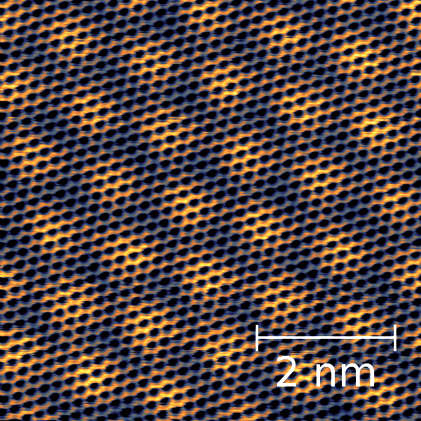With the growing development of two-dimensional materials, from graphene in 2004 to transition metal dichalcogenides more recently, the underlying physics of Moirés has been recently the topic of a renewed interest and of intense debates. Moirés can be imaged by Scanning Tunneling Microscopy with a resolution down to the atomic scale and are characterized by an apparent periodic nano-undulation of the surface, with alternating hills and valleys. These undulations are the result of both vertical atomic displacements (mostly in the upper crystal) and of electronic wave functions interferences. However, these images can be misleading and the observed undulations may not reflect the actual periodicity of the moiré. This sometimes led to wrong crystallographic descriptions in the literature, with for example unrealistic strain values in the crystals. We have developed a rigorous mathematical description of the Moiré patterns, based on the Fourier analysis of these images which allows elucidating the exact superstructure and eventually calculating the strains and shears in the two-dimensional crystals. Our analysis is based on a universal classification of all the possible commensurabilities between the two layers.
Knowing the true crystallographic structures of stacked two-dimensional materials is absolutely required if one aims at designing devices with targeted functionalities. Indeed the mutual interaction between the layers, even the weakest ones such as van der Waals interactions, may impact drastically their band structure and therefore their electronic properties. For the sole case of graphene, it has been shown, both theoretically and experimentally, that the details of the stacking between a monolayer graphene and its substrate may lead to a strong reduction of the Fermi velocity, change of energy of singularities in the electronic density of states, quantum localization, the opening of a band gap and a metal-to-insulator transition. Moreover, the Moiré itself leads to the folding of the graphene band structure,
i.e. to replica electronic bands.
In practice, a commensurate stacking of two-dimensional materials may have different equivalent realizations, leading to a degenerate ground-state of the Moiré. Depending on boundary conditions, the co-existence of these degenerate phases leads to the formation of singularities, named kinks, which behave like solitons. Here again, the very existence of these topological defects deeply modifies the global electronic properties of the system. For example, kinks may behave as metallic objects in an otherwise insulating matrix. However, at this stage, the commensurability hypothesis has to be questioned and the experimental observation of solitons remains challenging.
This work is the fruit of a collaboration between Néel Institute (CNRS) and PHELIQS (CEA) laboratories and is at the heart of Alexandre Artaud’s PhD thesis.
